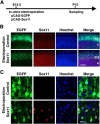Sox11 Balances Dendritic Morphogenesis with Neuronal Migration in the Developing Cerebral Cortex
- PMID: 27225767
- PMCID: PMC6601844
- DOI: 10.1523/JNEUROSCI.3250-15.2016
Sox11 Balances Dendritic Morphogenesis with Neuronal Migration in the Developing Cerebral Cortex
Abstract
The coordinated mechanisms balancing promotion and suppression of dendritic morphogenesis are crucial for the development of the cerebral cortex. Although previous studies have revealed important transcription factors that promote dendritic morphogenesis during development, those that suppress dendritic morphogenesis are still largely unknown. Here we found that the expression levels of the transcription factor Sox11 decreased dramatically during dendritic morphogenesis. Our loss- and gain-of-function studies using postnatal electroporation and in utero electroporation indicate that Sox11 is necessary and sufficient for inhibiting dendritic morphogenesis of excitatory neurons in the mouse cerebral cortex during development. Interestingly, we found that precocious suppression of Sox11 expression caused precocious branching of neurites and a neuronal migration defect. We also found that the end of radial migration induced the reduction of Sox11 expression. These findings indicate that suppression of dendritic morphogenesis by Sox11 during radial migration is crucial for the formation of the cerebral cortex.
Significance statement: Because dendritic morphology has profound impacts on neuronal information processing, the mechanisms underlying dendritic morphogenesis during development are of great interest. Our loss- and gain-of-function studies indicate that Sox11 is necessary and sufficient for inhibiting dendritic morphogenesis of excitatory neurons in the mouse cerebral cortex during development. Interestingly, we found that precocious suppression of Sox11 expression caused a neuronal migration defect. These findings indicate that suppression of dendritic morphogenesis by Sox11 during radial migration is crucial for the formation of the cerebral cortex.
Keywords: Sox11; cerebral cortex; dendritic development; radial migration; transcription factor.
Copyright © 2016 the authors 0270-6474/16/365775-10$15.00/0.
Conflict of interest statement
The authors declare no competing financial interests.
Figures









Comment in
-
Balancing Dendrite Morphogenesis and Neuronal Migration during Cortical Development.J Neurosci. 2016 Oct 19;36(42):10726-10728. doi: 10.1523/JNEUROSCI.2425-16.2016. J Neurosci. 2016. PMID: 27798127 Free PMC article. No abstract available.
References
Publication types
MeSH terms
Substances
LinkOut - more resources
Full Text Sources
Other Literature Sources
Molecular Biology Databases
